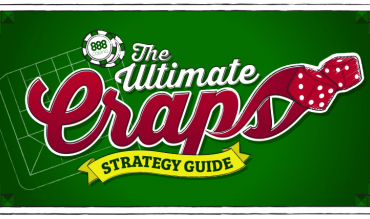
HOW TO SHOOT DICE
CRAPS PASS LINE RULES FOR SHOOTING DICE
There are dozens of other bets available, but the pass line is fundamental to craps play.
It's a multiroll wager that begins with a "comeout roll." Before the comeout, players who want to bet on pass place chips directly in front of them in the area marked "pass line."
The shooter is required to make a pass bet. If you do not want to bet on pass, the dice go to the next shooter.
On the comeout roll, if the roll is 7 or 11, pass bettors win. If the roll is 2, 3 or 12 - the numbers designated as "craps" - pass bettors lose.
If the comeout roll is 5. 6. 7, 8, 9 or 10. that number is designated as the "point." The dealer flips a plastic disc to the side labeled "on," and places it in the point number's box on the table.
Now the shooter's goal changes. To win, he must roll that point number again before rolling a 7. If he repeats the point number, all pass bettors win, but if he first rolls a 7, all pass bettors lose.
Once the point is established, no other numbers but 7 and the point matter in deciding the pass bet. Other numbers could decide other bets you and other players make, but the outcome of the pass bet is down to the shooter, the point number and 7.
Losing by rolling a 7 after a point has been established is called "sevening out." It's only after the shooter sevens out that the dice pass to a new shooter. If the shooter rolls a loser 2, 3 or 12 on the comeout, he keeps shooting.
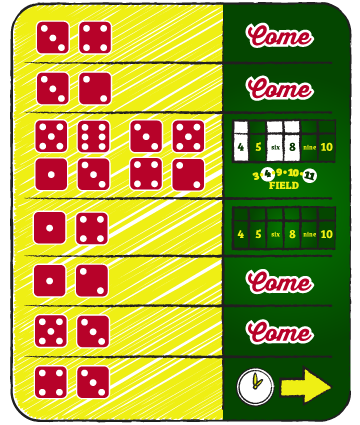 Let's try a sequence on how to shoot dice.
Let's try a sequence on how to shoot dice.- On the comeout roll, the shooter rolls a 7. Pass bettors win.
- The next roll is another comeout. The shooter rolls a 5, which becomes a
point. - The next four rolls are 11, 8, 4 and 6. None of those matter on the pass
bet. You'll see some payoffs on winning bets and chips collected by the
dealer on losers, but those are on different wagers that don't affect the
pass bet. - The shooter rolls a 5. Pass bettors win.
- Because the pass bet has been decided, the next roll is a comeout to
start a new pass sequence. - The shooter rolls a 3 on the comeout. Pass bettors lose, but the shooter
keeps rolling because he did not seven out. - Again, the next roll is a comeout. The shooter rolls an 8, and that
becomes the point. - The shooter rolls a 7. Pass bettors lose. Now the shooter has sevened
out, and the dice pass clockwise around the table to the next shooter
LEARN HOW OTHER BETS WORK
Knowing the pass bet is essential, because shooters must bet pass and it helps determine whose turn it is to shoot.
But if you're going to be really comfortable at a craps table, you should know what's going on around you.
The Ultimate Craps Guide describes other wagers in detail, but here are a few to focus on: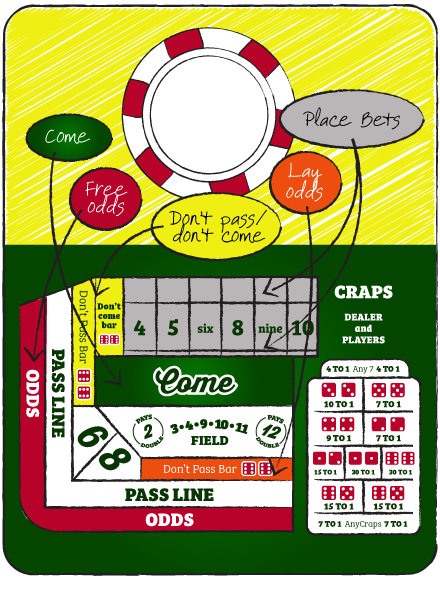
FREE ODDS
Once the point is established, you may back your pass or come bet with an odds bet. The free odds are paid at true odds, meaning there is no house edge on that portion of your bet.
DON'T PASS/DON'T COME
These are the near opposites of pass and come. Instead of winning when the shooter repeats a point number before rolling a 7, don't bettors win when the 7 comes first.
One point of difference is that while pass and come bettors lose when the comeout is 2, 3 or 12, don't bettors win only on 2 or 3, while a comeout roll of 12 is a push.
LAY ODDS
Just as pass/come bettors may back their bets with free odds, don't bettors may lay the odds, spotting the house true odds of winning. Again, these are paid at true odds and there is no house edge.
PLACE BETS
These are multiroll bets that skip the comeout. If you place 6, for example, you win if the shooter rolls a 6, but lose if a 7 comes first. No other numbers matter.
The lowest house edge comes if you place 6 or 8. Other numbers have higher edges.
These are some of the best bets at craps and are described in detail, along with other wagers and their house edges, elsewhere in the guide.
KNOW YOUR VOCABULARY AS A DICE SHOOTER
Craps practically has a language of its own, especially if you get into the slang some dealers use to call out different dice combinations.
You'll often hear "Yo-leven," or sometimes just "yo," for 11, but from some dealers you might also hear "six-five, no jive."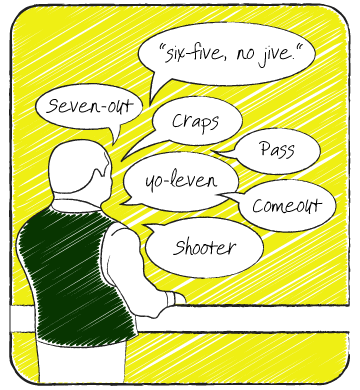 Craps practically has a language of its own, especially if you get into the slang some dealers use to call out different dice combinations.
Craps practically has a language of its own, especially if you get into the slang some dealers use to call out different dice combinations.
You'll often hear "Yo-leven," or sometimes just "yo," for 11, but from some dealers you might also hear "six-five, no jive."
You can pick up the slang as you go along, but there are a few normal terms you should know before you take your turn with the dice.
- Shooter: The player whose turn it is to roll the dice.
- Comeout: The initial roll of the pass sequence. The dealer usually willv alert the table that the next roll is a comeout by calling, "Coming out," or in the case of a change of shooter, "New shooter coming out."
- Pass: An area between two lines that extend all around the table is called the "pass line." A bet placed in that area is a pass bet, as described earlier in this chapter. If the shooter makes a point and pass bettors win, the shooter is said to have made a pass.
- Craps: Rolls of 2, 3 or 12 are called "craps" and are losers on the pass line if rolled on the comeout.
- The point: The number the shooter must roll before 7 to make a pass. That's determined if the comeout roll is 4, 5, 6, 8, 9 or 10 -- that number is designated as teh point.
- Seven out: Losing a pass bet by rolling a 7 before repeating the point.
HOW TO SHOOT DICE IN THE CASINO
Once you have the basic knowledge of the game and are ready to try shooting dice in a casino, there are procedures to follow:
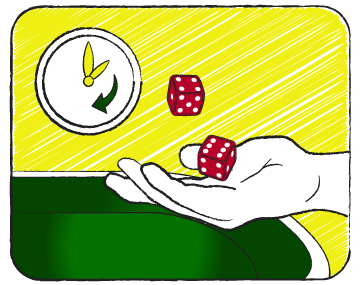 BECOMING THE SHOOTER
BECOMING THE SHOOTER
Once you take your place at the table, the dice will come to you in your turn.
When a shooter sevens out, the dice are offered to the next player clockwise around the table. When that player sevens out, the dice go to the next player, and so on around the table.
When it is your turn, the stickman will push several dice toward you - the stickman is one of the crew that runs the game. He's easy to spot because he has a large stick, curved at the end so he can hook the dice after each roll and bring them back to the shooter.
You may pick up dice and choose which two you want to shoot. The dice are identical to manufacturer's specification, but some players just think some dice feel luckier than others.
ROLLING THE DICE
Before shooting dice, you must make a bet on the pass line. When you get the go-ahead to roll, you must roll toward the end of the table that is farther away from you.
The casino wants to make sure rolls are as random as possible. As long random rolls bring up dice combinations in normal proportions, the odds of the game will hold up and the house will make money.
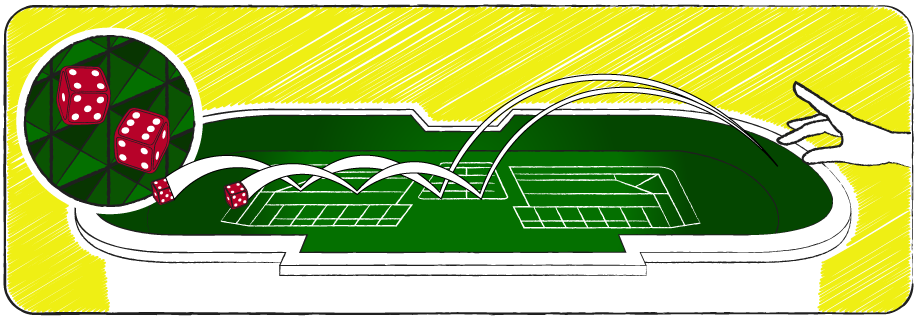
To insure random rolls, casinos take several measures:
- You, as the shooter, must loft the dice into the air. If the boxman, who is the chief of the crew operating the game, does not see the dice in an arc above the table, he can call no roll. In that case, your roll does not count, win or lose, and you must roll again.
- On your roll, the dice must hit the back wall at the end of the table. If the dice fall short of hitting the back wall, the boxman can call no roll.
- The table walls usually have pyramid-shaped bumps, designed so that instead of the dice bouncing off them in a predictable manner, they bounce at angles to randomize the roll.
- The padding under the felt on the table surface varies from casino to casino. A surface that creates more bounce on the roll helps to randomize results.
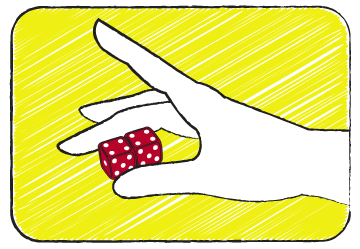 Keeping all that in mind, there are several ways shooters go about the physical roll of the dice:
Keeping all that in mind, there are several ways shooters go about the physical roll of the dice:
- Some shooters wrap their full hand around the dice, then give a backhand roll, with the back of their hand facing the wall toward which they're shooting.
- Some move the dice in their hand, cradling them among their thumb, index finger and middle finger and fling the dice toward the end.
- But the method favored by many is to put the dice side-by-side, square against each other, then pick up with the thumb and middle finger along the line between the dice, so the thumb touches both dice on one side and the middle finger touches both dice on the other. They then swing their full arm as a pendulum and release the dice in an arc.
HOW TO SHOOT DICE: YOUR GOAL AS SHOOTER
You must obey all the table rules. You must put sufficient arc on your roll to satisfy the boxman and your roll must hit the back wall.
However, hot rolls that make money for players usually involve a streak in which the shooter is rolling fewer 7s than usual. Fewer 7s mean more points made before seven-out.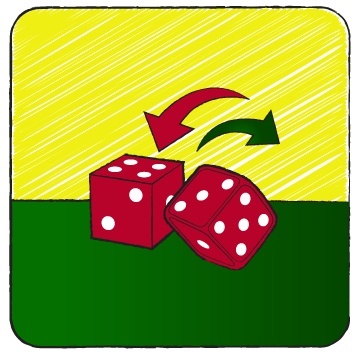 You can win with 7s on comeout rolls, but for players who back their pass bets with free odds, the big wins come by making the points. And you can't make the points when the dice keep landing on 7.
You can win with 7s on comeout rolls, but for players who back their pass bets with free odds, the big wins come by making the points. And you can't make the points when the dice keep landing on 7.
In the good times, you seem to get in a rhythm in which the point numbers are rolling and the 7s are few and far between. The question craps players have been asking themselves for ages is whether there's anything they can do to make the good times come more often.
Whether you're wagering on the pass line alone or on other bets, too, it doesn't take much deviation from the norm to swing the house edge in favor of players.
Take the place bets on 6 or 8, as described above. When 7s occur an average of once every six rolls, as they do in a random game, the house has a 1.52 percent edge -- for every $100 wagered, the house expects to keep $1.52.
But what if 7s don't come up once every six rolls? What if the shooter has a method that will depress 7s so they come up less often?
Dr. Don Catlin, a retired professor of mathematics and statistics, took on that problem a few years ago. Catlin calculated that a shooter reaches the turning point, taking a slight edge when he can depress the frequency of 7s to 1 in 6.1428. Depress the frequency to 1 in 7, and the players betting 6 and/or 8 take a whopping 8.333 percent edge over the house. That the gap from 1 in 6 rolls to 1 in 6.1428 is narrow doesn't make it easy. But those who practice dice control say they can get there.
HOW TO SHOOT DICE: DICE CONTROL
I first learned of dice control from Frank Scoblete, author of many best-selling books on casinos games including "Golden Touch Dice Control Revolution" and "Cutting Edge Craps." Famed blackjack expert Stanford Wong also took up the dice control question in his book, "Wong on Dice."
At its core, dice control is not about trying to roll specific numbers. No one claims to be able to step up to the table to roll 6s at will, or any other number.
Most of the emphasis is on decreasing the proportion of 7s once a point has been established. Some players going to the next level also try to increase the proportion of 7s on the comeout, so they win with more 7s on the comeout and also with fewer 7s after there's a point.
The method for doing so sounds easy, but please keep in mind this is a physical skill. Like other physical skills such as shooting free throws in basketball, bowling or shooting billiards, dice control requires a great deal of practice and muscle memory.
Not everyone who tries it will be able to put it into practice and get an edge over the house. Some players -- perhaps even most players -- will find they're never able to cross the bridge from random results.
Even those who are both skilled enough and practiced enough to control successfully will find there are days they're just out of rhythm. On such days, it's best to just walk away from the table.
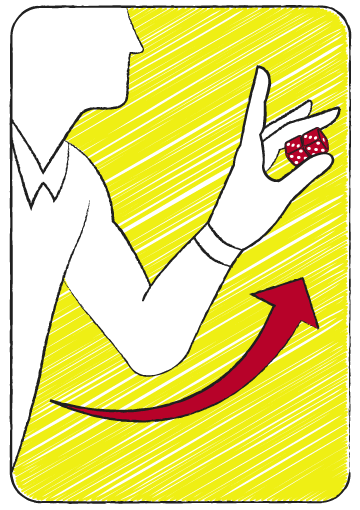 DICE CONTROL KEY POINTS
DICE CONTROL KEY POINTS
- Start by setting the dice. The starting point for most dice controllers is to set them so both dice have a 3 face on top, and to set themselves so the diagonal lines formed by the three spots align in the same direction on both dice.
It isn't necessary to have the 3s face up, but dice controllers like to have both dice show the same number. Starting with the dice showing 3s is common among craps players and doesn't set off any alarms among the crew that the shooter might be a dice controller.
However, no one wants to wait for the shooter to set the dice. So you need to learn to find the dice faces you want on top quickly. Time is money in a casino, and the crew won't let you slow down the game. - Pick up the dice between thumb and forefinger.
- Swing your arm in a pendulum motion and release: shoot the dice in a soft arc. You do not want to put any spin on the dice. The fewer rotations they make in the air, the better. The dice also should stay tight, close together in their arc. The more separation between them after you release, the more likely it is they will take random bounces in different directions when they land.
- The dice must hit the back wall and bounce on the table. However, your goal in releasing the dice softly and with rotation minimized is to take some of the randomizing factors out of the roll.
That means you want the dice to stop quickly and not bounce multiple times. The ideal roll will softly hit the back of the wall, bounce on the table surface once and come to a halt.
PRACTICING AT HOME
In theory, it all sounds easy enough: Swing your arm in a pendulum and release the dice gently so they bounce a minimum number of times.
In practice, it's a difficult physical skill that takes time to master. Dice control experts suggest you set aside up to an hour a day to practice your roll, and to practice every day. Given all the time and repetition it takes, you don't want to make casino play all your practice time. When you're playing in a casino, you have money on the line. Besides, when you're waiting for other shooters, you're not spending all that much time practicing your roll.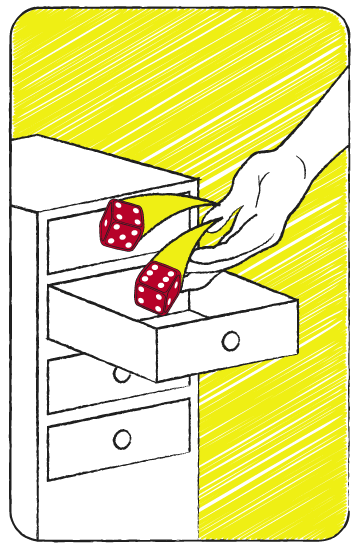 To get in enough practice time without the risk of big losing sessions, there are several methods you can use at home.
To get in enough practice time without the risk of big losing sessions, there are several methods you can use at home.
BUY A REGULATION TABLE
The method that most closely simulates casino conditions is to buy a regulation craps table and practice on that. There are several problems with that method. For one thing, in some jurisdictions, private ownership of gambling equipment is illegal. Even where legal, craps tables are expensive and take up a lot of space.
Only a few dedicated players with money to spend and plenty of space in their houses can go so far as to install a regulation table.
BUY OR BUILD A PRACTICE BOX
This is much easier on both space and your budget than trying to by a full table. Online searches can lead you to sites that will sell you practice rigs for a few hundred dollars, but also can find plans to build your own, if you're handy with the tools.
Commercially available practice rigs are small, about three feet wide by three feet deep, at regulation height, with foldable legs for easy storage. The back wall has regulation pyramids, and the surface has padded felt, usually about an inch and a half thick, to simulate the same conditions you'd find in a casino.
It's up to you to stand a normal distance away, take your normal stance for rolling the device, then take that pendulum swing and aim to have the dice softly hit that back wall.
In a pinch, just practice your roll throwing into any available surface. You can roll dice onto a bed or sofa, or into a dresser drawer. These won't give you realistic bounces so you get no accurate feedback from the numbers you roll. The idea is just to build muscle memory, to keep yourself in the habit of giving your arm that pendulum swing.
DICE CONTROL CONCLUSION
There are a few key points everyone who wants to try dice control should keep in mind.
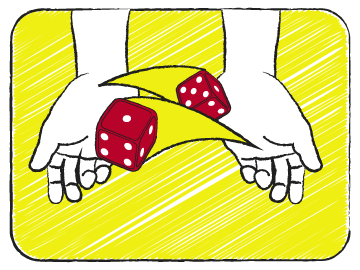 Attempting to control the dice is not for everyone, and it will not automatically make you a winner. Most players will wind up with random results and still face the same house edge.
Attempting to control the dice is not for everyone, and it will not automatically make you a winner. Most players will wind up with random results and still face the same house edge.- For those who do move forward with dice control, it's important to practice, practice, practice. Consistently rolling the dice with the same motion time after time is a physical skill, and it's easy to fall out of rhythm if you don't keep up the homework.
- Though a select few players claim to be able to increase the frequency of certain numbers, the basic aim of dice control is to decrease the frequency of 7s, leading to more passes.
- Learning dice control can be as inexpensive or expensive as you like, depending on your wants and needs.
You can practice the pendulum roll on your own with homemade equipment, or you can spend hundreds, even thousands of dollars on commercial practice rigs, seminars, private lessons and more.
Small stakes players or those who play infrequently will be best served by staying on the inexpensive side. There's no point in
spending more on practice tools than you'll actually wager in the casino.
Bigger players might find it worthwhile to explore their options, whether through the books by Scoblete and Wong or through
websites devoted to dice control.
Do keep in mind that dice control is no cure-all. Not everyone can do it, and some don't even believe it's possible. If you do decide to try, then practice regularly. Practice may not make perfect, but it certainly takes lots of practice to get better
